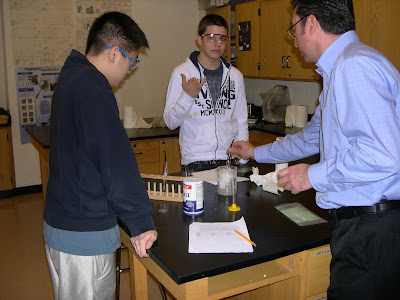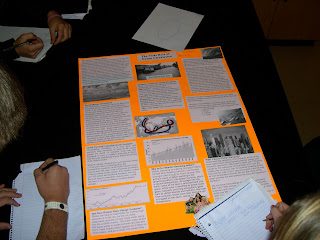Traditionally, the Core Biology classes examine the factors that affect the activity of the enzyme catalase. Catalase is a common enzyme found in liver, potatoes and turnips.
It catalyzes the conversion of hydrogen peroxide into hydrogen gas and oxygen gas. Mrs. Bastone's class used the Vernier Oxygen probes and the Labquest2 tablets to gather their data. They had some trouble getting meaningful results. Not all of the groups were able to calibrate their probes. Apparently the electrodes that sense the presence of oxygen have a limited life and eventually are not sensitive enough to pick up the voltage changes caused by the presence of oxygen on their surfaces.
Ms. Davies' class used the Vernier Gas Pressure probes in place of the Oxygen probes and all of her groups got better results when measuring the pressure within their reaction vessels as the oxygen gas built up over time. Mrs. Bastone plans to repeat the experiment with the Gas Pressure probes after the Spring Recess.
In both classes the students altered an established protocol to examine different factors that might affect the amount of gas produced overtime. Some of the independent (manipulated) variables used by the students in their experiments were: temperature (room temp, above room temp, below room temp), pH (acidic, neutral, basic environments) and catalase sources (beef liver, calf's liver, chicken liver, apples, strawberries and potatoes).
Science News and Happenings of Interest to the Bronxville School Community
Friday, March 22, 2013
Wednesday, March 20, 2013
Science Seminar April 3
Science
Seminar Series
Presents
Naomi Schwartz
Doctoral student, Columbia
University
Understanding
the causes and effects
of fire in the Peruvian Amazon
In recent years, wildfire activity has increased across the
Amazon. In the past, fire was very rare there, so these changes could have big
effects on biodiversity, ecosystems, and the carbon cycle. Most fires in the
Amazon are started by people, either intentionally, through the use of fire for
land management, or accidentally. Especially during drought years these fires
can burn out of control into nearby forests. Naomi
Schwartz is a Ph.D. student in ecology, evolution, and environmental biology at
Columbia University. Her work uses a combination of ground and satellite
measurements to understand the causes and effects of these fires in the
Peruvian Amazon. She is especially interested in understanding the
relationships between human activities and fire occurrence, and the effects
of fire on secondary forests.
Wednesday, April 3
7 pm
Bronxville High School Auditorium
Monday, March 18, 2013
Middle School Science Olympiad Team
 |
| Middle School Science 2012-2013 Olympiad Team |
On Saturday, March 2 the Middle School Science Olympiad team competed in the Lower Hudson Valley competition at Scarsdale Middle School. Congratulations to all the team members and their coach, 8th Grade Team Leader Jean Windels.
 |
| Anton and Zip are pleased with their medal win in the "Mission Possible" - competition in which they had to design and build a "Rube Goldberg device |
 |
| Kenny and David with their flying helicopter. |
 |
| Kenny and Michael snagged a first place medal for their performance in the "Dynamic Planet" event in which they answered questions about glaciers. |
 |
| Buz and Emmet won a medal for the "Helicopter Egg Drop" event, in which the students had to design a device that could drop an egg from a height of 8 meters without breaking the egg. |
 |
| Sasha and Kirsten also won medals for the "Helicopter Egg Drop" event. |
 |
| Kenny and Michael agreed to pose for this picture to display the back of the team "uniform" T-shirts. |
 |
| Kenny and David in the process of flying their helicopter. |
Chem II Freezing Point Depression Analysis
The Chem II students use differences in freezing point depression of
three unknown water solutions A, B and C to determine which of the
solutions contain sodium chloride, calcium chloride, and sucrose as the
solute, in this lab exercise presented by Mr. Nowak. Once that is determined they will be able to calculate the
molality of each solution from the data they collected. The students do
know that each solution has the same concentration.
 |
| James and Bailie use temperature probes to determine the temperature of three unknown solutions as they approach their freezing points, as Matthew and Jordan look on. |
 |
| Kenny and Max look on as Mr. Nowak checks their set up. |
 |
| Alina, Malika and Tatiana decided to use three separate ice baths to bring their solutions down to their freezing points, as Professor Maitland observes their technique during her classroom visit. |
Saturday, March 16, 2013
United States Coast Guard Summer Program
The United States Coast Guard is offering this one week program for high school juniors who may be interested in attending the Coast Guard Academy for college.
Friday, March 8, 2013
Biome Displays by Environmental Science Class
"Biomes are defined as the world's major communities,
classified according to the predominant vegetation and characterized by
adaptations of organisms to that particular environment" (Campbell, N.A. 1996. Biology, Fourth Edition. The Benjamin/Cummings Publishing Company, Inc. Menlo Park, CA.).
"The importance of biomes cannot be overestimated. Biomes have changed and moved many times during the history of life on Earth. More recently, human activities have drastically altered these communities. Thus, conservation and preservation of biomes should be a major concern to all." (http://www.ucmp.berkeley.edu/glossary/gloss5/biome/)
As an introduction to their unit on Global Warming/Climate change students in the class researched and produced posters on each of the major biomes found on Earth. The students then "visited" each station to examine and learn about each biome from their classmates, who prepared the posters.
"The importance of biomes cannot be overestimated. Biomes have changed and moved many times during the history of life on Earth. More recently, human activities have drastically altered these communities. Thus, conservation and preservation of biomes should be a major concern to all." (http://www.ucmp.berkeley.edu/glossary/gloss5/biome/)
As an introduction to their unit on Global Warming/Climate change students in the class researched and produced posters on each of the major biomes found on Earth. The students then "visited" each station to examine and learn about each biome from their classmates, who prepared the posters.
 |
| Students were encouraged to document the posters for later study using their smart phones. |
Wednesday, March 6, 2013
Environmental Science Climate Presentations
The environmental science class began their global warming unit of study by preparing and sharing displays describing the six major factors that contribute to climate. Pairs of student were each assigned a topic to prepare. The remaining students of the class then rotated through each station to learn about the factors.
 |
| Atmosphere Display |
 |
| Coriolis Effect Display |
 |
| Carbon Cycle Display |
 |
| Green House Effect Display |
 |
| Ocean Currents Display |
 |
| Solar Radiation Display |
 |
| Ethan explains how the Coriolis effect contributes to the climate of a particular region. |
 |
| Alex uses her presentation to explain how the Carbon Cycle contributes to climate. |
 |
| Asil clarifies the Green House Effect to his classmates. |
 |
| Claire describes and explains the various layers the compose the atmosphere and how they affect climate. |
 |
| Paul explains how climate is affected by solar radiation and the tilt of Earth's axis. |
 |
| Students take notes as Sally explains how Ocean Currents affect climate. |
 |
| Erin joins Ethan in debunking some common myths about the Coriolis Effect. |
Subscribe to:
Posts (Atom)


























